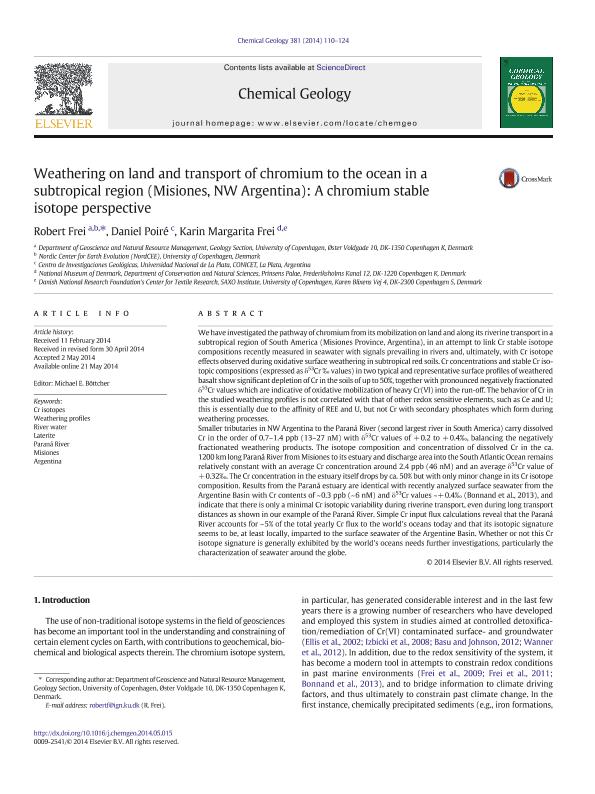Mostrar el registro sencillo del ítem
dc.contributor.author
Frei, Roberto
dc.contributor.author
Poire, Daniel Gustavo

dc.contributor.author
Frei, Karim Margarita
dc.date.available
2018-01-12T19:09:19Z
dc.date.issued
2014-08
dc.identifier.citation
Frei, Karim Margarita; Poire, Daniel Gustavo; Frei, Roberto; Weathering on land and transport of chromium to the ocean in a subtropical region (Misiones, NW Argentina): A chromium stable isotope perspective; Elsevier Science; Chemical Geology; 381; 8-2014; 110-124
dc.identifier.issn
0009-2541
dc.identifier.uri
http://hdl.handle.net/11336/33118
dc.description.abstract
We have investigated the pathway of chromium from its mobilization on land and along its riverine transport in a subtropical region of South America (Misiones Province, Argentina), in an attempt to link Cr stable isotope compositions recently measured in seawater with signals prevailing in rivers and, ultimately, with Cr isotope effects observed during oxidative surface weathering in subtropical red soils. Cr concentrations and stable Cr isotopic compositions (expressed as δ53Cr ‰ values) in two typical and representative surface profiles of weathered basalt show significant depletion of Cr in the soils of up to 50%, together with pronounced negatively fractionated δ53Cr values which are indicative of oxidative mobilization of heavy Cr(VI) into the run-off. The behavior of Cr in the studied weathering profiles is not correlated with that of other redox sensitive elements, such as Ce and U; this is essentially due to the affinity of REE and U, but not Cr with secondary phosphates which form during weathering processes. Smaller tributaries in NW Argentina to the Paraná River (second largest river in South America) carry dissolved Cr in the order of 0.7–1.4 ppb (13–27 nM) with δ53Cr values of + 0.2 to + 0.4‰, balancing the negatively fractionated weathering products. The isotope composition and concentration of dissolved Cr in the ca. 1200 km long Paraná River from Misiones to its estuary and discharge area into the South Atlantic Ocean remains relatively constant with an average Cr concentration around 2.4 ppb (46 nM) and an average δ53Cr value of + 0.32‰. The Cr concentration in the estuary itself drops by ca. 50% but with only minor change in its Cr isotope composition. Results from the Paraná estuary are identical with recently analyzed surface seawater from the Argentine Basin with Cr contents of ~ 0.3 ppb (~ 6 nM) and δ53Cr values ~+ 0.4‰ (Bonnand et al., 2013), and indicate that there is only a minimal Cr isotopic variability during riverine transport, even during long transport distances as shown in our example of the Paraná River. Simple Cr input flux calculations reveal that the Paraná River accounts for ~ 5% of the total yearly Cr flux to the world's oceans today and that its isotopic signature seems to be, at least locally, imparted to the surface seawater of the Argentine Basin. Whether or not this Cr isotope signature is generally exhibited by the world's oceans needs further investigations, particularly the characterization of seawater around the globe.
dc.format
application/pdf
dc.language.iso
eng
dc.publisher
Elsevier Science

dc.rights
info:eu-repo/semantics/openAccess
dc.rights.uri
https://creativecommons.org/licenses/by-nc-sa/2.5/ar/
dc.subject
Cr Isotopes
dc.subject
Weathering Profiles
dc.subject
River Water
dc.subject
Laterite
dc.subject
Paraná River
dc.subject
Misiones
dc.subject
Argentina
dc.subject.classification
Meteorología y Ciencias Atmosféricas

dc.subject.classification
Ciencias de la Tierra y relacionadas con el Medio Ambiente

dc.subject.classification
CIENCIAS NATURALES Y EXACTAS

dc.title
Weathering on land and transport of chromium to the ocean in a subtropical region (Misiones, NW Argentina): A chromium stable isotope perspective
dc.type
info:eu-repo/semantics/article
dc.type
info:ar-repo/semantics/artículo
dc.type
info:eu-repo/semantics/publishedVersion
dc.date.updated
2018-01-12T16:16:56Z
dc.journal.volume
381
dc.journal.pagination
110-124
dc.journal.pais
Países Bajos

dc.journal.ciudad
Amsterdam
dc.description.fil
Fil: Frei, Roberto. Universidad de Copenhagen; Dinamarca
dc.description.fil
Fil: Poire, Daniel Gustavo. Consejo Nacional de Investigaciones Científicas y Técnicas. Centro Científico Tecnológico Conicet - La Plata. Centro de Investigaciones Geológicas. Universidad Nacional de La Plata. Facultad de Ciencias Naturales y Museo. Centro de Investigaciones Geológicas; Argentina
dc.description.fil
Fil: Frei, Karim Margarita. Universidad de Copenhagen; Dinamarca. National Museum of Denmark; Dinamarca
dc.journal.title
Chemical Geology

dc.relation.alternativeid
info:eu-repo/semantics/altIdentifier/doi/http://dx.doi.org/10.1016/j.chemgeo.2014.05.015
dc.relation.alternativeid
info:eu-repo/semantics/altIdentifier/url/http://www.sciencedirect.com/science/article/pii/S000925411400254X
Archivos asociados
